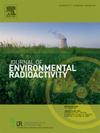Mechanical retardation of actinide-bearing colloid migration from an underground repository: Theory and experiment
IF 1.9
3区 环境科学与生态学
Q3 ENVIRONMENTAL SCIENCES
引用次数: 0
Abstract
A necessary condition for the sustainable development of nuclear power is the safe disposal of vitrified high-level radioactive waste from the processing of spent nuclear fuel in underground repositories. Their safety depends on the rate of radionuclide transport by groundwater from the repository to the biosphere. A significant fraction of the radionuclides is carried by groundwater in colloidal form. The radionuclide-bearing colloid (radiocolloid) is the most mobile and therefore the most ecologically hazardous form of radionuclide transport. The radiocolloid can be retained mechanically in the rock if the colloid particle size is larger than diameter of rock pore channels. Transport of radionuclide-bearing colloid by groundwater is considered. (1) A technique for determining the size distribution of pore channels in the rock is developed. It is based on measurements of the gas permeability of rock samples at different pressures. (2) The technique is applied to rock samples from the Nizhnekanskiy Massif (Russia), which has been selected for the development of a high-level radioactive waste repository. (3) Simulated radionuclide-bearing colloids were obtained by water leaching of aged aluminum phosphate glass with radionuclide simulants. The glass composition is similar to that used for vitrification of liquid HLW at the Russian radiochemical plant. (4) The size distribution of the colloid was determined by filtering the leachates through membranes of different pore sizes. (5) Mechanical retention of the colloid by the rock is estimated theoretically. The estimation is based on size distributions of colloid particles and diameters of pore channels in the rock. It is shown that 99% of the colloidal form of the actinide simulants (Ce, Nd, U) can be mechanically retained in the rock of the Nizhnekanskiy Massif.
含放线菌胶体从地下贮藏库迁移的机械阻滞:理论与实验
核电可持续发展的一个必要条件是将处理乏核燃料产生的玻璃化高放射性废物安全处置在地下贮存库中。其安全性取决于放射性核素通过地下水从储存库迁移到生物圈的速度。相当一部分放射性核素以胶体形式被地下水携带。含放射性核素的胶体(放射性胶体)流动性最强,因此也是对生态危害最大的放射性核素迁移形式。如果胶体的粒径大于岩石孔隙通道的直径,放射性胶体就会被机械地保留在岩石中。本文考虑了含放射性核素胶体通过地下水的迁移。(1) 开发了一种确定岩石孔隙通道大小分布的技术。该技术基于不同压力下岩石样本的气体渗透率测量。(2) 将该技术应用于下甘斯克山丘(俄罗斯)的岩石样本,该山丘已被选为开发高放射性废物储存库的地点。(3) 通过用放射性核素模拟物水浸老化的磷酸铝玻璃,获得了含放射性核素的模拟胶体。玻璃成分与俄罗斯放射化学工厂用于液态高放射性废物玻璃化的成分相似。(4) 通过不同孔径的滤膜过滤浸出液,确定胶体的粒度分布。(5) 从理论上估计了岩石对胶体的机械截留作用。估算的依据是胶体颗粒的尺寸分布和岩石中孔隙通道的直径。结果表明,99% 的锕系元素模拟物(铈、钕、铀)的胶体形式可被机械地保留在下甘斯基山丘的岩石中。
本文章由计算机程序翻译,如有差异,请以英文原文为准。
求助全文
约1分钟内获得全文
求助全文
来源期刊

Journal of environmental radioactivity
环境科学-环境科学
CiteScore
4.70
自引率
13.00%
发文量
209
审稿时长
73 days
期刊介绍:
The Journal of Environmental Radioactivity provides a coherent international forum for publication of original research or review papers on any aspect of the occurrence of radioactivity in natural systems.
Relevant subject areas range from applications of environmental radionuclides as mechanistic or timescale tracers of natural processes to assessments of the radioecological or radiological effects of ambient radioactivity. Papers deal with naturally occurring nuclides or with those created and released by man through nuclear weapons manufacture and testing, energy production, fuel-cycle technology, etc. Reports on radioactivity in the oceans, sediments, rivers, lakes, groundwaters, soils, atmosphere and all divisions of the biosphere are welcomed, but these should not simply be of a monitoring nature unless the data are particularly innovative.
 求助内容:
求助内容: 应助结果提醒方式:
应助结果提醒方式:


